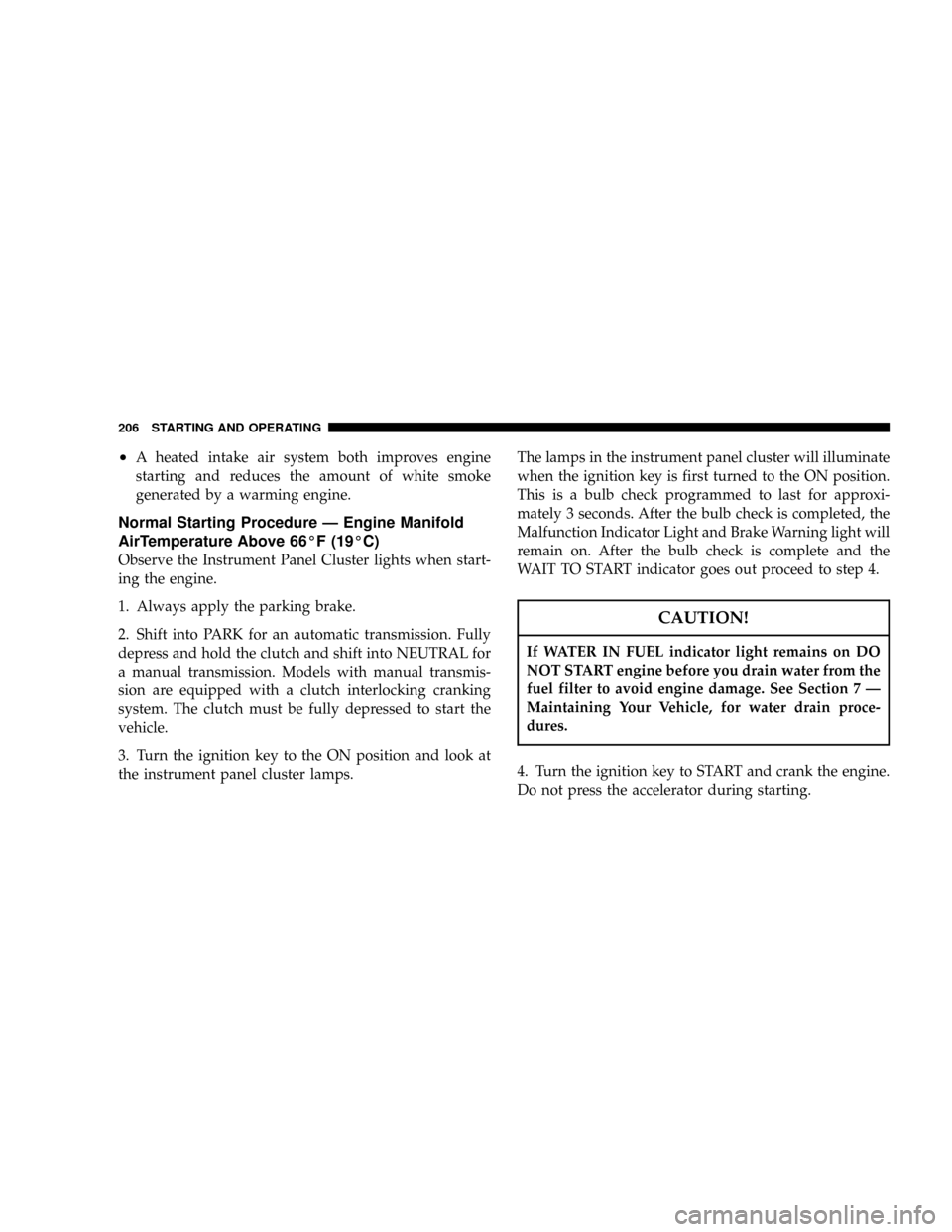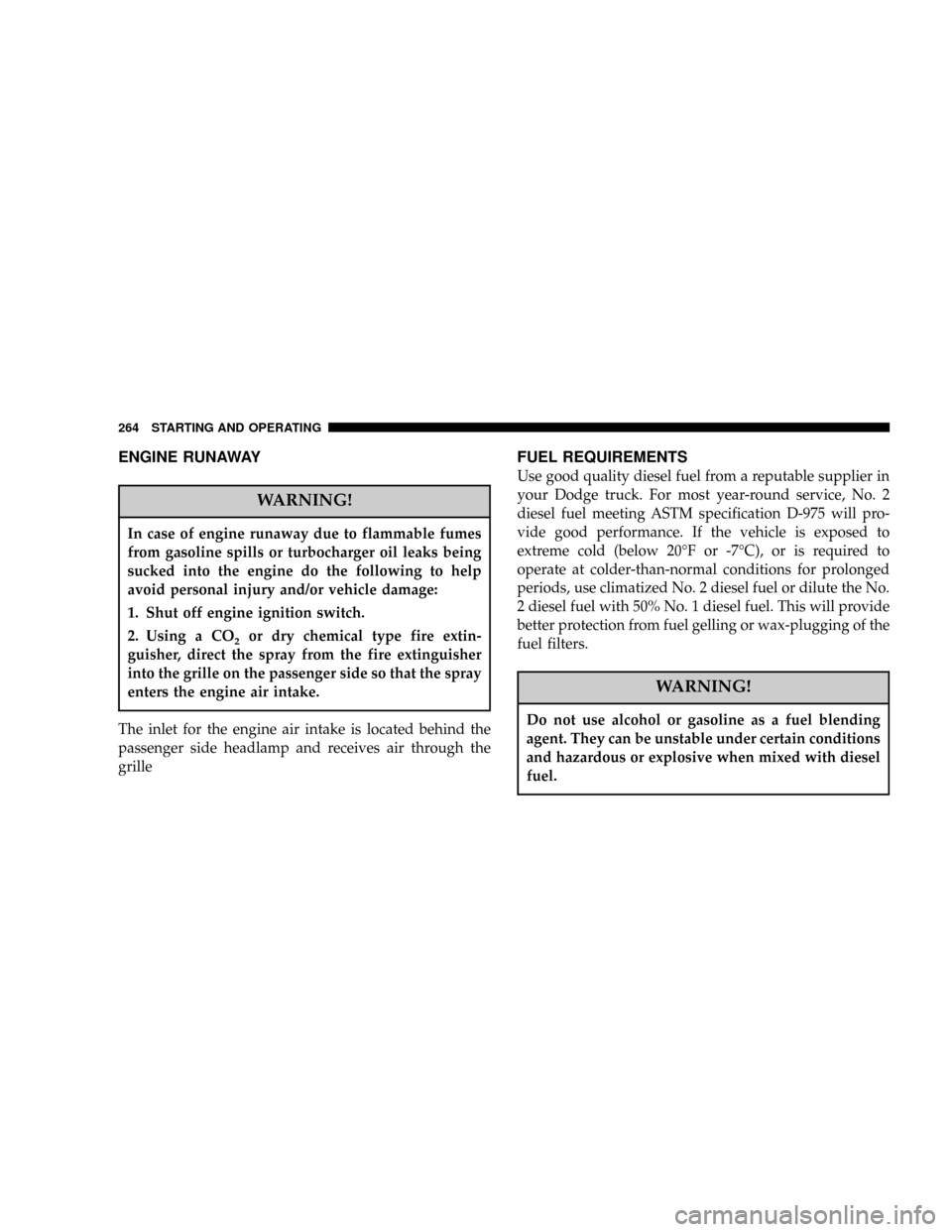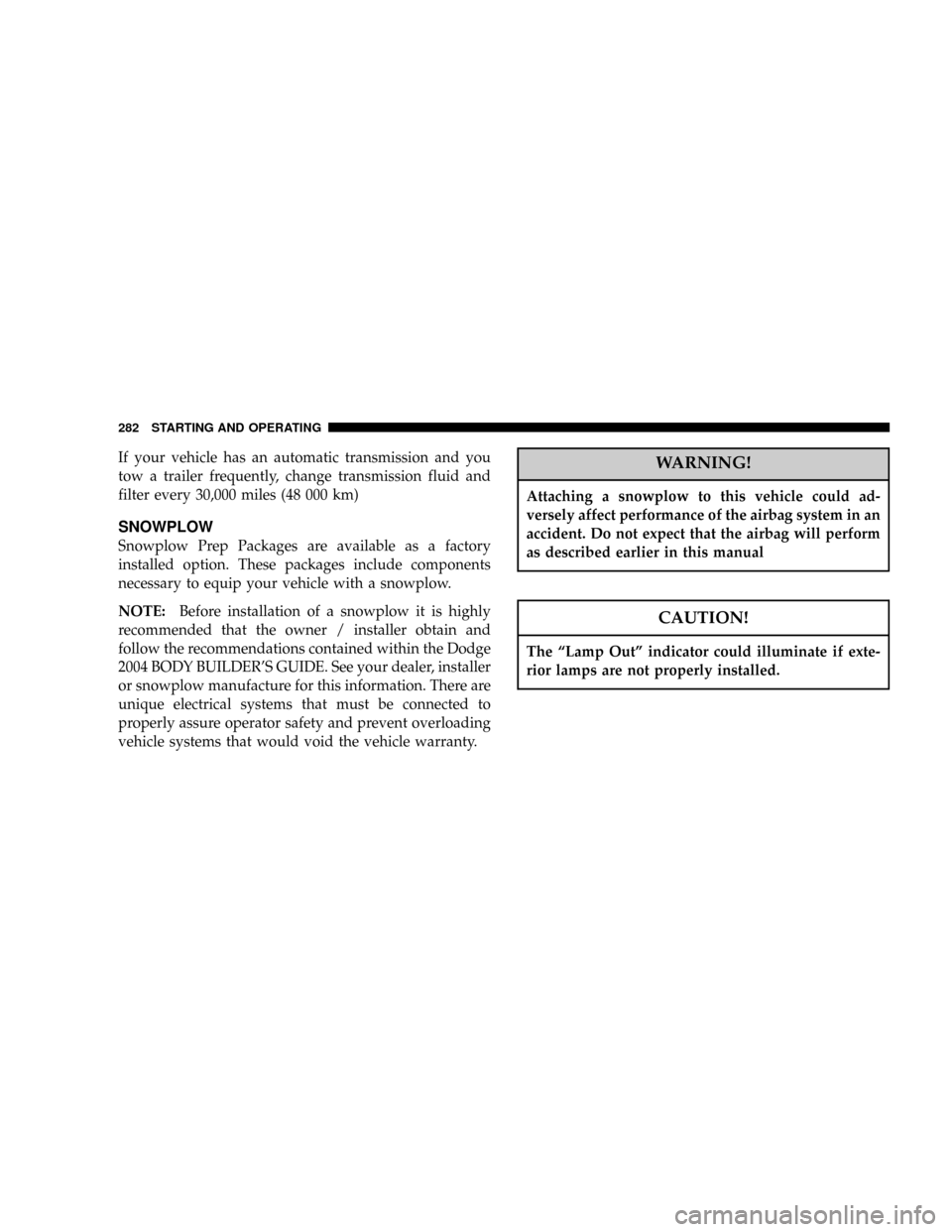Page 206 of 426

²A heated intake air system both improves engine
starting and reduces the amount of white smoke
generated by a warming engine.
Normal Starting Procedure Ð Engine Manifold
AirTemperature Above 66ÉF (19ÉC)
Observe the Instrument Panel Cluster lights when start-
ing the engine.
1. Always apply the parking brake.
2. Shift into PARK for an automatic transmission. Fully
depress and hold the clutch and shift into NEUTRAL for
a manual transmission. Models with manual transmis-
sion are equipped with a clutch interlocking cranking
system. The clutch must be fully depressed to start the
vehicle.
3. Turn the ignition key to the ON position and look at
the instrument panel cluster lamps.The lamps in the instrument panel cluster will illuminate
when the ignition key is first turned to the ON position.
This is a bulb check programmed to last for approxi-
mately 3 seconds. After the bulb check is completed, the
Malfunction Indicator Light and Brake Warning light will
remain on. After the bulb check is complete and the
WAIT TO START indicator goes out proceed to step 4.
CAUTION!
If WATER IN FUEL indicator light remains on DO
NOT START engine before you drain water from the
fuel filter to avoid engine damage. See Section 7 Ð
Maintaining Your Vehicle, for water drain proce-
dures.
4. Turn the ignition key to START and crank the engine.
Do not press the accelerator during starting.
206 STARTING AND OPERATING
Page 264 of 426

ENGINE RUNAWAY
WARNING!
In case of engine runaway due to flammable fumes
from gasoline spills or turbocharger oil leaks being
sucked into the engine do the following to help
avoid personal injury and/or vehicle damage:
1. Shut off engine ignition switch.
2. Using a CO
2or dry chemical type fire extin-
guisher, direct the spray from the fire extinguisher
into the grille on the passenger side so that the spray
enters the engine air intake.
The inlet for the engine air intake is located behind the
passenger side headlamp and receives air through the
grille
FUEL REQUIREMENTS
Use good quality diesel fuel from a reputable supplier in
your Dodge truck. For most year-round service, No. 2
diesel fuel meeting ASTM specification D-975 will pro-
vide good performance. If the vehicle is exposed to
extreme cold (below 20ÉF or -7ÉC), or is required to
operate at colder-than-normal conditions for prolonged
periods, use climatized No. 2 diesel fuel or dilute the No.
2 diesel fuel with 50% No. 1 diesel fuel. This will provide
better protection from fuel gelling or wax-plugging of the
fuel filters.
WARNING!
Do not use alcohol or gasoline as a fuel blending
agent. They can be unstable under certain conditions
and hazardous or explosive when mixed with diesel
fuel.
264 STARTING AND OPERATING
Page 267 of 426

Avoid Using Contaminated Fuel
Fuel that is contaminated by water or dirt can cause
severe damage to the engine fuel system which is not
covered by the warranty. Proper maintenance of the
engine fuel filter and fuel tank is essential. (See Section 7
for Maintenance Procedures).
NOTE:Climatized diesel fuel is a blend of Number 2
and Number 1 Diesel fuel which reduces the temperature
at which wax crystals form in the fuel.
Bulk Fuel Storage
If you store quantities of fuel, good maintenance of the
stored fuel is also essential. Fuel contaminated with
water will promote the growth of ªmicrobes.º These
microbes form ªslimeº that will clog fuel filters and lines.
Drain condensation from the supply tank and change the
line filter on a regular basis.
Fuel Specifications
The Cummins Turbocharged, Charge Air Cooled, Diesel
engine has been developed to take advantage of the high
energy content and generally lower cost No. 2 diesel fuel
or No. 2 climatized diesel fuels. Experience has shown
that it also operates on No. 1 diesel fuels or other fuels
within the specifications in the following chart.
NOTE:As sufficient testing has not been completed,
organically blended diesel fuels (e.g. biodiesel, ethanol,
and methanol blends) are not recommended or approved
for use with your Cummins Diesel equipped Dodge Ram
Truck.
NOTE:In addition, commercially available fuel addi-
tives are not necessary for the proper operation of your
Cummins Diesel equipped Dodge Ram Truck.
NOTE:No. 1 diesel fuel should only be used where
extended arctic conditions (-10ÉF or 23ÉC) exist.
STARTING AND OPERATING 267
5
Page 282 of 426

If your vehicle has an automatic transmission and you
tow a trailer frequently, change transmission fluid and
filter every 30,000 miles (48 000 km)
SNOWPLOW
Snowplow Prep Packages are available as a factory
installed option. These packages include components
necessary to equip your vehicle with a snowplow.
NOTE:Before installation of a snowplow it is highly
recommended that the owner / installer obtain and
follow the recommendations contained within the Dodge
2004 BODY BUILDER'S GUIDE. See your dealer, installer
or snowplow manufacture for this information. There are
unique electrical systems that must be connected to
properly assure operator safety and prevent overloading
vehicle systems that would void the vehicle warranty.
WARNING!
Attaching a snowplow to this vehicle could ad-
versely affect performance of the airbag system in an
accident. Do not expect that the airbag will perform
as described earlier in this manual
CAUTION!
The ªLamp Outº indicator could illuminate if exte-
rior lamps are not properly installed.
282 STARTING AND OPERATING
Page 317 of 426
MAINTAINING YOUR VEHICLE
CONTENTS
mEngine Compartment....................320
N5.9L/5.9L HO Cummins Turbo Diesel.......320
mOnboard Diagnostic System (OBD II).........321
mReplacement Parts......................322
mDealer Service.........................322
mService Information.....................322
mMaintenance Procedures..................325
NEngine Oil..........................325
NDrive Belt...........................331NEngine Air Cleaner Filter................331
NDraining Fuel/Water Separator Filter.......334
NMaintenance Free Batteries...............336
NAir Conditioner Maintenance.............338
NPower Steering Ð Fluid Check............339
NFront Suspension Ball Joints..............340
NSteering Linkage Ð Inspection............340
NFront Axle Universal Drive Joints And Pivot
Bearings............................340
7
Page 331 of 426

Disposing Of Used Engine Oil And Filter
Care should be taken in disposing of the used engine
fluids from your vehicle. Used fluids, indiscriminately
discarded, can present a problem to the environment.
Contact your local dealer, service station, or governmen-
tal agency for advice on recycling programs and where
used fluids and filters can be safely discarded in your
area.
Drive Belt
Inspection
Check the belt for intersecting cracks.
²Transverse (across the belt width) cracks are accept-
able.
²Longitudinal (direction of belt length) cracks that
intersect with transverse cracks are NOT acceptable.Replace the belt if it has unacceptable cracks, is frayed or
has pieces of material missing.
The engine speed sensor, located near the damper, should
be inspected for damage if a belt is frayed.
Engine Air Cleaner Filter
CAUTION!
All air entering the engine intake must be filtered.
The abrasive particles in unfiltered air will cause
rapid wear to engine components.
The air filter housing on your Diesel Ram is equipped
with a Filter MinderŸ. This is an air flow restriction
gauge that will indicate when the filter element needs to
be replaced.
MAINTAINING YOUR VEHICLE 331
7
Page 332 of 426

Do not remove the top of the air filter housing to
inspect the filter element on your diesel engine under
normal operating conditions.
The clear plastic housing on the Filter MinderŸ allows
you to view the amount of air pressure drop across the
filter element. It consists of a diaphragm and a calibrated
spring sealed inside the plastic housing. As the aircleaner filter becomes clogged and air pressure drop
across the filter element increases, a yellow disc travels
along a graduated scale on the side of the Filter
MinderŸ.
The yellow disc will always show the greatest restriction
experienced by the filter element. When the disc reaches
the red zone, the filter element may need to be replaced.
There is no other time or mileage interval for changing
the air cleaner filter element.
If the vehicle experiences a sudden loss of engine power
when being driven in heavy snow or rain or when
plowing snow, check the Filter MinderŸ
²If the Filter MinderŸ is showing a plugged filter, the
filter should be visually inspected for snow/ice build
up or extreme water saturation.
²If any of these conditions exist, the filter element
should be replaced.
332 MAINTAINING YOUR VEHICLE
Page 333 of 426
A visual inspection of the air cleaner filter element is
never recommended under normal circumstances. A
badly restricted element may appear clean while a soiled
element may be quite effective in filtering particles
without restricting air flow. Rely on the Filter MinderŸ
to determine when a filter change is necessary.
After a new filter element is inserted, press the rubber
button on the top of the Filter MinderŸ. This action will
reset the yellow disc to the clean position.CAUTION!
When using an engine cleaner or a degreaser, be sure
to wrap and tape the Filter MinderŸ to protect the
plastic housing from damage and discoloration.
NOTE:Many aftermarket performance air filter ele-
ments do not adequately filter the air entering the engine.
Use of such filters can severely damage your engine and
such damage is not covered by the manufacturer's war-
ranty.
MAINTAINING YOUR VEHICLE 333
7